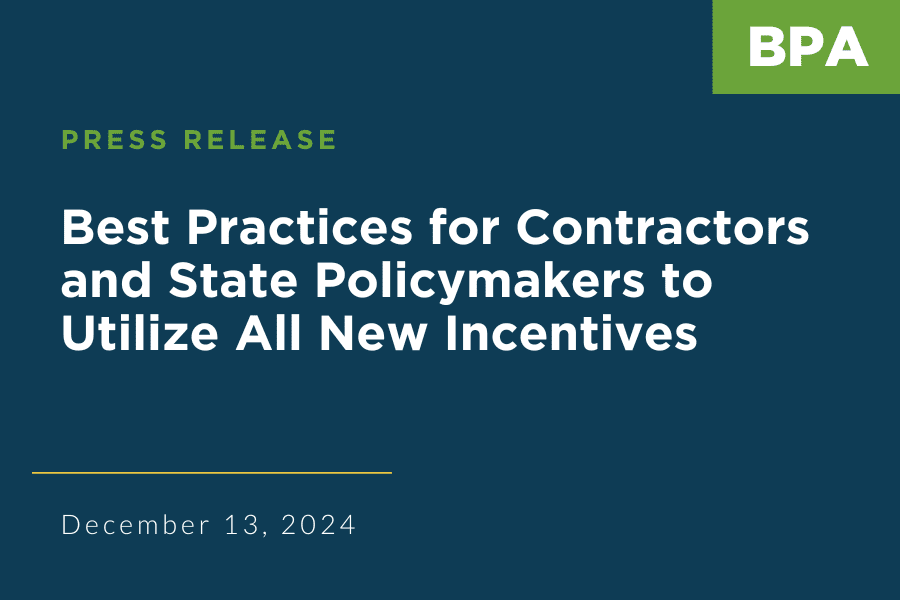For Immediate Release
December 13, 2024
Media Contact: Stephanie Ebbs
stephanie@storyandreach.com
The new recommendations emphasize the importance of training, collaboration, and providing reliable information for customers
Washington, DC, December 12, 2024 – The nation’s largest association of building performance contractors is out with a series of new reports detailing best practices to ensure millions of American consumers and contractors benefit from the Inflation Reduction Act’s residential incentives. This includes the $8.8 billion in Home Energy Rebates that will hit the market in most states in 2025.
Building Performance Association (BPA) compiled these reports in collaboration with AnnDyl Policy Group (AnnDyl) based on input from hundreds of contractors in one-on-one conversations, state-based workshops, and an extensive national survey over the past year.
“In 2025 we are going to see the long-awaited Home Energy Rebates reach the marketplace in most states,” said Kara Saul Rinaldi, President and CEO of AnnDyl, Chief Policy Officer of BPA, and lead author on all three papers.
“These rebates can be used with existing federal tax incentives as well as state utility incentives, but it can be complicated. These papers help contractors prepare for the incentives and share their concerns and recommendations with state policymakers who are putting final touches on the programs.”
Reports:
- Contractor Perspectives for States Designing New Federal Home Upgrade Incentive Programs – This report compiles input from contractors to provide critical information for policymakers designing state-specific rebate programs.
- The Residential Capital Stack – This report shares opportunities to maximize the benefits to households by combining incentive types by income level as a resource for policymakers and contractors.
- Recommendations for Contractors Seeking to Engage in Historic Federal and State Incentive Opportunities – This report provides recommendations for contractors to effectively prepare to help their customers access incentives.
The Department of Energy’s Home Energy Rebates program authorized a historic $8.8 billion as part of the Inflation Reduction Act signed in 2022. Ten states and the District of Columbia are offering rebates now and 39 have applied for full funding to launch their programs, as of December 10, 2024.
The Home Energy Rebates include the HOMES Rebates (also called Home Efficiency Rebates), which provide incentives for whole house upgrades that reduce a home’s overall energy use, and Home Electrification and Appliance Rebates (HEAR), that award grants to states or tribal territories to provide rebates for home electrification measures such as heat pumps, electric cooktops, or efficiency upgrades like insulation. The 25C Tax incentives are currently in the marketplace, supporting home upgrades for insulation, heat pumps, audits and other home performance measures. In addition, many states have utility programs and financing options that may be used in unison to complete the projects.
“Homeowners need these incentives to cut the cost of their energy bills through energy efficiency home upgrades. These inflation-reducing incentives won’t work if contractors don’t have easy access to providing them,” said Steve Skodak, President and CEO of BPA.
DOE estimates the Home Energy Rebate program alone could collectively save homeowners $1 billion a year on energy bills and support over 50,000 American jobs. Individual household savings vary based on income. As outlined in the Residential Capital Stack report, states and contractors can combine eligible incentive programs to get households their maximum savings.
“When homeowners hear about financial incentives, they reach out to their contractors for help and then the contractors reach out to their state programs – it is critical that the blending of these incentives are understood,” Skodak said.
###
